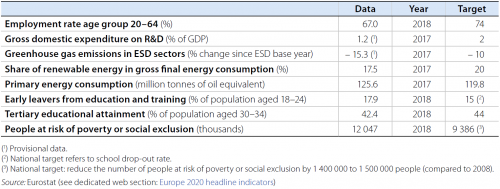Archive:Europe 2020 indicators - Spain
Data extracted in August 2019.
No planned update.
This Statistics Explained article is outdated and has been archived - for recent information on Europe 2020 strategy see here.

Source: Eurostat (see dedicated web section: Europe 2020 headline indicators)
Explanations on this radar chart are available here.
This article is part of a set of statistical articles on Europe 2020 strategy, focusing on the situation in Spain.
Full article
Overview
Spain exceeded its national target on GHG emissions in ESD sectors by 5.3 percentage points in 2017. Although the country had already met its goal on primary energy consumption in 2016, the situation deteriorated in 2017, pushing Spain 5.8 Mtoe away from its goal. Despite a gradual increase in share of renewable energy in gross final energy consumption, in 2017 Spain was still 2.5 percentage points from its 2020 national target. By reducing the school drop-out rate by 13.8 percentage points between 2008 and 2018, Spain made substantial progress towards its 2020 national target. In contrast, in 2018 the share of 30- to 34-year-olds with tertiary education was almost the same as in 2008, leaving a distance of 1.6 percentage points to the national target of 44 %. Since 2008, the number of people at risk of poverty or social exclusion has risen sharply. Despite improvements since 2015, Spain would need to lift some 2.7 million people out of being at risk of poverty to meet its 2020 objective. Although the country’s employment rate has picked up since 2014, in 2018 it was still 7.0 percentage points behind its national target — the second largest gap in the EU. R&D spending has also fallen, however, the country was closer to its national target than the EU as a whole was to the EU 2020 target in 2017.

Source: Eurostat (see dedicated web section: Europe 2020 headline indicators)
Data sources
More information about the origin of the data and the calculation of indicators can be obtained via the Europe 2020 indicators dedicated website.
Under 'Main tables', click on the icons next to the indicators:
- 'Explanatory texts (metadata)' for a detailed overview of the collection and compilation methods;
- 'Information on the leaf' for data availability per country.
A more general overview of quality procedures can be found in Implementation of standard reference metadata for indicators - the ESMS Indicator Profile (ESMS-IP) (PDF file).
Context
Europe 2020 is the EU’s agenda for jobs and growth for the current decade. It emphasises smart, sustainable and inclusive growth as a way to strengthen the EU economy and prepare its structure for the challenges of the next decade. As a main objective, the strategy strives to deliver high levels of employment, productivity and social cohesion in the Member States, while reducing the impact on the natural environment.
Direct access to
- Towards robust quality management for European Statistics - Communication from the Commission to the European Parliament and the Council COM(2011) 211 final.
- Regulation (EC) No 223/2009 of 11 March 2009 on European statistics